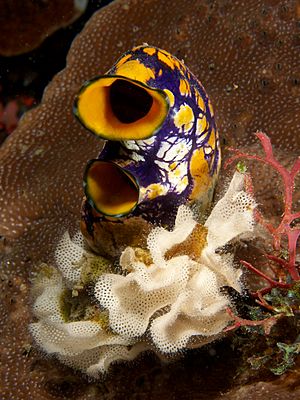Ascidiacea facts for kids
Quick facts for kids Ascidiacea |
|
|---|---|
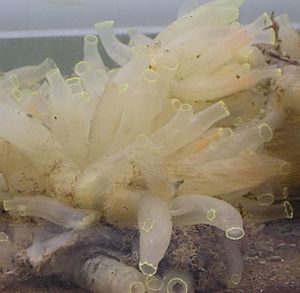 |
|
| Ciona intestinalis, commonly known as the vase tunicate or as a sea squirt | |
| Scientific classification |
|
| Kingdom: | Animalia |
| Phylum: | Chordata |
| Subphylum: | Tunicata |
| Class: | Ascidiacea Blainville, 1824 |
| Orders and unplaced genera | |
|
|
Ascidiacea, often called sea squirts, are amazing ocean animals. They are part of a group called Tunicata. Sea squirts are like small, sac-shaped creatures that live in the sea. They are invertebrates, meaning they don't have a backbone.
Sea squirts are filter feeders. This means they get their food by filtering tiny bits of food from the water. They have a tough outer layer called a "tunic." This tunic is made of a special sugar-like material.
You can find sea squirts all over the world. They usually live in shallow ocean water. They like water that is a bit salty. Unlike some of their relatives that swim freely, sea squirts stay in one place. After they are babies, they attach themselves firmly to things like rocks or shells.
There are about 2,300 different kinds of sea squirts. They come in three main types. Some live alone, called solitary ascidians. Others live in groups, attaching at their bases. The third type, called compound ascidians, are made of many tiny individuals. These tiny individuals are called zooids. They form large colonies that can be several meters long!
Sea squirts eat by pulling water in through a tube called the oral siphon. The water goes into their mouth and throat. It then flows through small, mucus-covered slits. These slits are like gills. The water then goes into a chamber called the atrium. Finally, the water leaves through another tube called the atrial siphon.
Contents
What Does a Sea Squirt Look Like?
Sea squirts are usually round or cylinder-shaped. They can be from about 0.5 to 10 centimeters (0.2 to 4 inches) big. One end of their body is always stuck to a hard surface. This could be a rock, coral, or something similar. Some species have root-like parts that help them hold on tight.
Their body is covered by a smooth, thick tunic. This tunic is often quite stiff. It is made of cellulose, which is also found in plants. The tunic also has proteins and calcium salts. Unlike a snail's shell, the tunic is living tissue. It even has its own blood supply. In some species that live in colonies, the tunics of different individuals are joined together.
The top part of the sea squirt has two openings, called siphons. When you take a sea squirt out of the water, it often squirts water out of these siphons. This is how they got their common name, "sea squirt"!
The sea squirt's body can have up to three parts. These parts are not always easy to see. The first part holds the throat. The middle part, called the abdomen, holds most of the other organs. The last part, the postabdomen, holds the heart and reproductive organs. In many sea squirts, the last two parts are missing. Their organs are then found closer to the front.
How Do Sea Squirts Eat?
The throat is the first part of the sea squirt's digestive system. A special groove in the throat makes a sticky substance called mucus. Tiny hairs, called flagella, help move this mucus. The mucus spreads like a sheet across the throat. As water flows through the gill-like slits, tiny food particles like plankton get stuck in the mucus.
The mucus with the trapped food then moves to a ridge on the back of the throat. This ridge guides the food down into the oesophagus, which is like a food pipe. The oesophagus leads to a stomach in the abdomen. The stomach releases special chemicals, called enzymes, to break down the food.
From the stomach, an intestine goes upwards. It ends in a short rectum and anus. Waste then leaves the body through a chamber called the cloaca, which is near the atrial siphon. In some colonial species, many individuals might share one cloaca.
How Does Blood Move in Sea Squirts?
The sea squirt's heart is a curved, muscular tube. It is located near the stomach or in the postabdomen. Each end of the heart opens into a blood vessel. These vessels are connected by a network of spaces called sinuses. Blood flows through these sinuses.
What's really unusual is that the sea squirt's heart changes the direction it pumps blood every three to four minutes! It has two areas that control the pumping. First one area takes over, pushing blood one way. Then the other area takes over, pushing blood the opposite way.
Sea squirts have different types of blood cells. Some collect waste like uric acid. Other cells help form the tunic. In some species, these cells contain iron (making blood red) or vanadium (making blood green).
Sea Squirt Nervous System
Sea squirts have a very simple nervous system. It is made from a small tube of cells. They don't have a true brain. Instead, they have a main cluster of nerves, called a ganglion. This ganglion is located between the two siphons. It sends nerves throughout the body.
Sea squirts don't have special eyes or ears. But their body wall has many tiny sensors. These sensors can feel touch. They can also detect chemicals in the water and sense light.
Sea Squirt Life Cycle
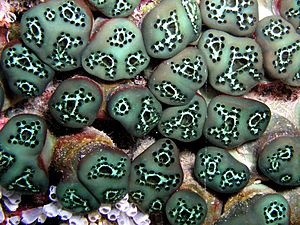
Almost all sea squirts are hermaphrodites. This means each individual has both male and female reproductive parts. Adult sea squirts stay in one place. Their reproductive organs are found in their abdomen or postabdomen. Each has one testis (male part) and one ovary (female part). These parts release their cells into the cloaca.
Sea squirts have different ways of reproducing. Solitary sea squirts, which live alone, release many eggs into the water. At the same time, other sea squirts release sperm. Fertilization happens in the seawater.
A fertilized egg then develops into a tiny, free-swimming larva. This larva looks a bit like a tadpole. It swims for about 12 hours to a few days. Then, it finds a good spot to settle down. In less than 36 hours, it changes into a young sea squirt.
The larva has a long tail with muscles. It also has a hollow nerve tube and a notochord. These features show that sea squirts are related to animals with backbones, like us! But some sea squirts have even lost their tails as they evolved.
The larva uses special sensors to find the right surface to settle on. These sensors can detect light, gravity, and touch. When its front end touches a surface, it releases a sticky substance. This glue helps it attach permanently.
Once attached, the larva goes through a big change called metamorphosis. It loses its tail and fins. Its organs rearrange to their adult positions. The throat gets bigger. The sea squirt becomes sexually mature in just a few weeks. This change, where the adult seems simpler than the larva, is sometimes called "retrogressive metamorphosis."
Colonial Sea Squirts: Living Together
Many colonial sea squirts can reproduce in two ways: sexually and asexually. Colonies can live for many decades. A colony is made up of many individual parts called zooids. Zooids in a colony are usually genetically identical. Sometimes, they even share the same blood flow.
Sexual Reproduction in Colonies
Colonial sea squirts have different ways of releasing their offspring. Some release sperm and eggs into the water. Fertilization happens near the parent colonies. The tiny larvae that result can be carried far away by ocean currents. These larvae eventually settle down and grow into new colonies.
Other colonial sea squirts keep their embryos inside their bodies. Sperm from a nearby colony (or even from the same colony) enters the atrial siphon. Fertilization happens inside the sea squirt. The embryos then develop inside the parent. When they are ready, these larger, tadpole-like larvae leave the parent. They usually settle very close to the parent colony. This means that colonies in one area are often closely related.
Asexual Reproduction in Colonies
Many colonial sea squirts can also reproduce without sperm and eggs. This is called asexual reproduction. The ways they do this can be very different.
In some simple types, the members of the colony are connected by root-like parts called stolons. Small buds can grow on these stolons. These buds contain food storage cells. When they are big enough, they can break off and grow into a new adult sea squirt.
In other species, a part of the animal can stretch out and break into separate buds. These buds can then form a new colony. In some cases, parts of the animal can even break down into small pieces of tissue. Each piece can then grow into a new individual.
Sometimes, budding starts soon after the larva settles. For example, in the Didemnidae family, the individual basically splits into two. One part grows a new digestive system, and the other grows a new throat.
Sea Squirts in Their Environment
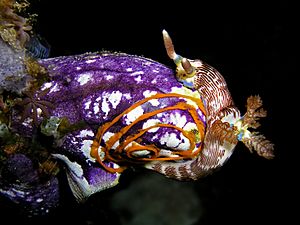
Sea squirts are excellent at filtering water. Because of this, they can collect pollutants from the water. This makes some species good indicators of pollution.
Over the last few hundred years, many of the world's harbors have been taken over by sea squirts from other places. These non-native sea squirts attach to ship hulls or to other introduced animals like oysters. Sea squirts can grow quickly because they mature fast. They also tolerate many different environments and don't have many predators.
These unwanted sea squirt populations cause problems. They can cover docks, ship hulls, and farmed shellfish, leading to economic issues. They can also harm natural underwater areas by smothering native animal species.
Many animals eat sea squirts. These include nudibranchs, flatworms, molluscs, crabs, sea stars, fish, birds, and sea otters. People also eat sea squirts in many parts of the world. You can find them in Japan, Korea, Chile, and Europe.
To protect themselves, many sea squirts store a very high amount of vanadium in their blood. Some also have a very low pH (meaning they are acidic) in their tunic. They can also produce chemicals that are harmful to predators. Some of these chemicals are even being studied for use in medicine.
How Sea Squirts Evolved
Sea Squirt Fossils
Sea squirts have soft bodies, so they don't often turn into fossils. This means we don't have many old sea squirt fossils. The oldest reliable sea squirt fossil is Shankouclava shankouense. It was found in rocks from the early Cambrian period in South China. There are also two mysterious older species from the Ediacaran period. These might be related to sea squirts.
Sea Squirt Family Tree
Scientists used to think sea squirts were closely related to two other groups, Thaliacea and Larvacea. But now, with new genetic evidence, we know that sea squirts are actually found in different branches of the Tunicata family tree. This means they are not all from one single common ancestor within that group.
| Tunicata |
|
||||||||||||||||||||||||
How People Use Sea Squirts
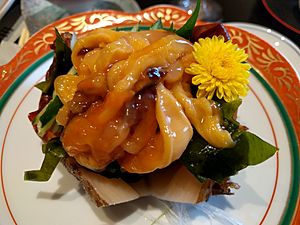
Sea Squirts as Food
Many types of sea squirts are eaten as food around the world.
The Sea pineapple (Halocynthia roretzi) is grown in Japan (where it's called hoya or maboya) and Korea (meongge). When eaten raw, it has a chewy texture and a unique taste. Styela clava is farmed in Korea. It's called mideoduk and is added to seafood dishes. There's even a special dish called tunicate bibimbap on Geojae island.
Microcosmus species from the Mediterranean Sea are eaten in France (figue de mer), Italy (limone di mare), and Greece (fouska). People eat them raw with lemon, or in salads with olive oil, lemon, and parsley.
The piure (Pyura chilensis) is used in Chile. It's eaten raw and also in seafood stews.
Pyura praeputialis is known as cunjevoi in Australia. Long ago, Aboriginal people ate it. Now, it's mostly used as fishing bait.
Sea Squirts in Science Research
Sea squirts are very useful for scientists studying how animals develop. They are good models for understanding how chordates (animals with a notochord, like us) grow.
Sea squirt embryos are simple, grow fast, and are easy to study. Because their embryos have few cells, scientists can study complex processes at a very detailed level. The eggs of some species are clear, which is great for seeing things with special lights. Also, their cells are naturally colored, so scientists can easily track how they develop from beginning to end.
Sea squirts are also important because of their unique place in evolution. They are like a link between simple chordates and animals with backbones. Scientists can compare the genes of sea squirts with those of other animals like flies, nematodes, and mammals. This helps them learn about how chordates evolved.
Images for kids
See also
 In Spanish: Ascidiáceos para niños
In Spanish: Ascidiáceos para niños


